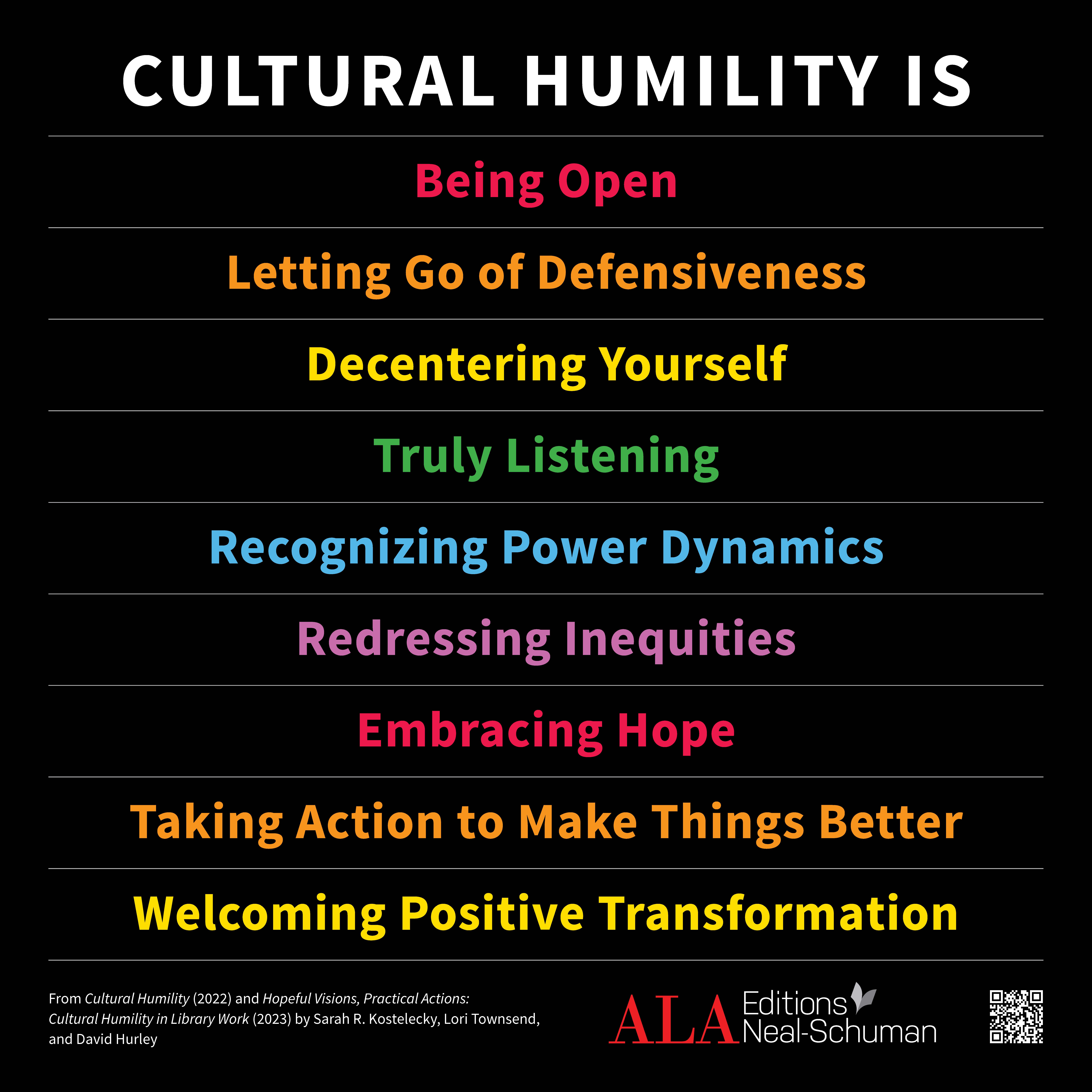Cultural Humility: More Elements of Practice
a guest post by Sarah R. Kostelecky, Lori Townsend, and David A. Hurley
This is the second post of two about cultural humility in libraries, an approach useful in day-to-day interactions with the potential to enable structural change. For a brief explanation of cultural humility and additional context, please read our first post (in fact, you may want to start there). Here we continue sharing details of some core elements of a practice of cultural humility from the ALA Editions poster supporting the book Hopeful Visions, Practical Actions:  Cultural Humility in Library Work.
Cultural Humility in Library Work.
Cultural Humility is Embracing Hope
In order to make positive change, we have to believe that change is possible. This means allowing ourselves to hope that things can get better. For many of us, hope feels nearly impossible because we have been disappointed so often in the past and the current situation may feel overwhelming. Maintaining hope means not giving in to cynicism and low expectations. Embracing hope means we celebrate small wins, appreciate those working with us to make change, keep moving, and continue seeking change.
Cultural Humility is Taking Action to Make Things Better
Cultural humility is not only a mindset and a way of looking at the world, it is also primarily a practice — a way of moving through the world. If the status quo is inequitable and causing harm, cultural humility asks us to take risks and change that status quo. Self-reflection and changes in attitude can help us do this work, but the work itself is composed of actions, small and large. Through taking action, we hold ourselves and the organizations we work in accountable.
Cultural Humility Is Redressing Inequities
Much of cultural humility is about enabling us to see structural barriers and inequities that we might otherwise not see because of our own positionality. But seeing them isn’t enough. A practice of cultural humility includes a commitment to redressing these inequities. For librarians in leadership positions, this might mean changing the policies and services that are creating the barriers, whether across the whole library or one’s department. For those without the direct power to change structures, it might be reducing harm on a more individual scale.
Cultural Humility is Welcoming Positive Transformation
Embracing change can be a challenge because change can be scary and difficult, especially if it affects long held beliefs and practices. Yet, resisting any change can close the door to both positive and unwelcome change. If we can be ok with the idea of not knowing, this can help us be open to and engage with positive shifts in life. We cannot know the future or the impact of the change in our policies and practices, but if we are willing to try something new and listen to people who want change, there is an opportunity to improve things for everyone.
Bonus Elements
There are a couple of elements of practice that didn’t quite work as pithy phrases for the poster. We wanted to add them here, where we have space for a little extra explanation.
 Cultural Humility Is Engaging your Curiosity
Cultural Humility Is Engaging your Curiosity
When you engage your curiosity, it becomes a joy to discover new ways to see the world. You are delighted to be continually surprised by new perspectives, and your own view is constantly getting wider. Curiosity can help us uncover structural issues and incorrect assumptions, and move from defensiveness to openness. This is lifelong learning - an attitude of discovery rather than mastery. But we want to avoid a demanding curiosity, one that assumes a right to know, and so asserts on others an obligation to share.
Cultural Humility is Making Mistakes
Mistakes are expected! A focus on avoiding mistakes likely hinders a practice of cultural humility. We should, of course, endeavor not to hurt or offend others, educating ourselves about others and their contexts can help with this. But if we are to make change, we must try new things. In the trying, we will inevitably make mistakes: obvious mistakes, stupid mistakes, funny mistakes, well-meant mistakes, awful mistakes, embarrassing mistakes. Over time, we can get better at recovering — learning to correct the mistake, make amends, and forgive ourselves — and keep going. Continued effort and a willingness to risk mistakes builds trust and is essential to a practice of cultural humility.
Cultural humility offers a chance for us to see others as they are and for us to be similarly recognized and appreciated. We think it is a good way of interacting with the world, one that can reduce harm - one that can make things better.
We would love to hear from you about what resonates with you, what confuses or worries you, and what you think about cultural humility and the potential for change in our profession. If you attend 2023 ALA Annual, please grab a poster and if you see one of us, come over and introduce yourself and we can talk about it together.
Read Part One of this blog post series and learn more at the ALA Store
